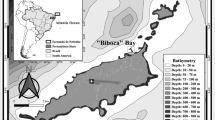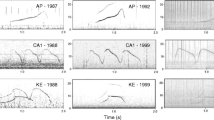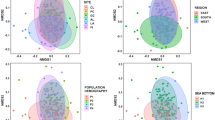Summary
Mother-calf whistle exchanges were recorded from temporarily captured free-ranging bottlenose dolphins from 1975 to 1989. This is part of a long-term research project studying social structure and behavior of a community of approximately 100 dolphins in waters near Sarasota, Florida. Analysis of whistle exchanges from 12 mothercalf pairs shows that signature whistles can remain stable for periods up to at least 12 years. We looked for effects of vocal learning on the development of the signature whistle by comparing whistles of calves to those of their mothers. Eight female calves produced whistles distinct from those of their mothers, while four male calves produced whistles similar to those of their mothers. Male calves appeared to produce a greater proportion of whistles other than the signature whistle (termed “variants”). We hypothesize that these sex differences in whistle vocalizations may reflect differences in the roles males and females play in the social structure of the community.
Similar content being viewed by others
References
Caldwell MC, Caldwell DK (1965) Individualized whistle contours in bottlenosed dolphins (Tursiops truncatus). Nature 207:434–435
Caldwell MC, Caldwell DK (1968) Vocalization of naive captive dolphins in small groups. Science 159:1121–1123
Caldwell MC, Caldwell DK (1972), Vocal mimicry in the whistle mode by an Atlantic bottlenosed dolphin. Cetology 9:1–8
Caldwell MC, Caldwell DK (1979) The whistle of the Atlantic bottlenosed dolphin (Tursiops truncatus) — ontogeny. In: Winn HE, Olla BL (eds) Behavior of marine animals, vol 3, Cetaceans. Plenum Press, New York, pp 369–401
Caldwell MC, Caldwell DK, Turner RH (1970) Statistical analysis of the signature whistle of an Atlantic bottlenosed dolphin with correlations between vocal changes and level of arousal. Technical Report Number 8, Los Angeles County Museum of Natural History Foundation
Caldwell MC, Caldwell DK, Miller JF (1973) Statistical evidence for individual signature whistles in the spotted dolphin, Stenella plagiodon. Cetology 16:1–21
Cheney DL, Seyfarth RM (1986) The recognition of social alliances by vervet monkeys. Anim Behav 34:1722–1731
Graycar PJ (1976) Whistle dialects of the Atlantic bottlenosed dolphin, Tursiops truncatus. PhD Thesis, University of Florida, University Microfilms, Ann Arbor
Hohn AA, Scott MD, Wells RS, Sweeney JC, Irvine AB (1989) Growth layers in teeth from known-age, free-ranging bottlenose dolphins. Mar Mammal Sci 5:315–342
Irvine AB, Wells RS (1972) Results of attempts to tag Atlantic bottlenosed dolphins, Tursiops truncatus. Cetology 12:1–5
Irvine AB, Scott MD, Wells RS, Kaufmann JH (1981) Movements and activities of the Atlantic bottlenose dolphin, Tursiops truncatus, near Sarasota, Florida. Fish Bull US 79:671–688
Kroodsma DE (1982) Learning and the ontogeny of sound signals in birds. In: Kroodsma DE, Miller EH (eds) Acoustic communication in birds, vol 2. Academic Press, New York, pp 1–20
Marler P (1976) An ethological theory of the origin of vocal learning. In: Harnad SR, Steklis HD, Lancaster J (eds) Origins and evolution of language and speech. Ann NY Acad Sci 280: 386–395
Marler P, Peters S (1981) Sparrows learn adult song and more from memory. Science 213:780–782
McBride AF, Kritzler H (1951) Observations on pregnancy, parturition, and postnatal behavior in the bottlenose dolphin. J Mammal 32:251–266
Newman JD, Symmes D (1982) Inheritance and experience in the acquisition of primate acoustic behavior. In: Snowdon C, Brown CH, Petersen M (eds) Primate communication. Cambridge University Press, Cambridge, pp 259–278
Payne K, Tyack P, Payne R (1983) Progressive changes in the songs of humpback whales (Megaptera novaeangliae): a detailed analysis of two seasons in Hawaii. In: Payne R (ed) Communication and behavior of whales. AAAS selected symposium series. Westview Press, Boulder, CO, pp 9–57
Ralls K, Morelli P, Gish S (1985) Vocalizations and vocal mimicry in captive harbor seals, Phoca vitulina. Can J Zool 63:1050–1056
Richards DG, Wolz JP, Herman LM (1984) Vocal mimicry of computer-generated sounds and vocal labelling of objects by a bottlenosed dolphin, Tursiops truncatus. J Comp Psychol 87:10–28
Scott MD, Wells RS, Irvine AB, Mate BR (1990) Tagging and marking studies on small cetaceans. In: Leatherwood S, Reeves R (eds) The bottlenose dolphin. Academic Press, San Diego, pp 489–514
Seyfarth RM, Cheney DL (1986) Vocal development in vervet monkeys. Anim Behav 34:1640–1658
Shane SH, Wells RS, Wuersig B (1986) Ecology, behavior and social organization of the bottlenose dolphin: a review. Mar Mammal Sci 2:34–63
Tyack P (1986) Whistle repertoires of two bottlenosed dolphins, Tursiops truncatus: mimicry of signature whistles? Behav Ecol Sociobiol 18:251–257
Walters JR, Seyfarth RM (1986) Conflict and cooperation. In: Smuts BB, Cheney DL, Seyfarth RM, Wrangham RW, Struhsaker TT (eds) Primate societies. University of Chicago Press, Chicago, pp 306–317
Wells RS (1986) Structural aspects of dolphin societies. PhD Thesis, University of California, Santa Cruz
Wells RS, Irvine AB, Scott MD (1980) The social ecology of inshore odontocetes. In: Herman LM (ed) Cetacean behavior: mechanisms and functions. Wiley, New York, pp 263–317
Wells RS, Scott MD, Irvine AB (1987) Structural aspects of dolphin societies. In: Genoways HH (ed) Current mammology, vol 1. Plenum Press, New York London, pp 247–305
Author information
Authors and Affiliations
Rights and permissions
About this article
Cite this article
Sayigh, L.S., Tyack, P.L., Wells, R.S. et al. Signature whistles of free-ranging bottlenose dolphins Tursiops truncatus: stability and mother-offspring comparisons. Behav Ecol Sociobiol 26, 247–260 (1990). https://doi.org/10.1007/BF00178318
Received:
Accepted:
Issue Date:
DOI: https://doi.org/10.1007/BF00178318




